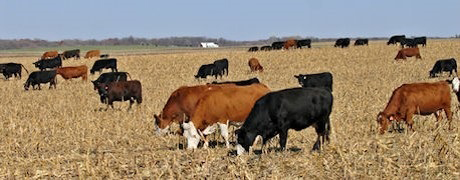
By Kristen Ulmer, Beef Systems Extension Educator
Nebraska has 9.5 million acres harvested for corn grain with an average yield of 178 bu/ac. For every bushel of corn grain, there are 16 pounds of husk and leaf left on the field. There is an opportunity to utilize this valuable resource for cattle feed. However, only about 52 percent of the Nebraska corn acres are grazed.
The benefit to the crop producer is the opportunity to bring in additional income by renting acres for grazing. The use of shredding or strip tilling due to increased crop residue on the field may be reduced or eliminated due to cattle removing a portion on the corn residue. What effect does utilization of the corn residue have on the following year’s crop yield?
Corn residue left on the field provides organic matter and nutrients for the field, while maintaining soil cover over the winter (soil insulation and moisture entrapment). Research indicates that no-till farming improves soil moisture, prevents soil moisture loss and builds up organic matter over time. With increased corn yields, there are greater quantities of corn residue covering the fields.
A 16-year study evaluating an irrigated corn field in an annual corn-soybean rotation indicated that cattle grazing corn residue in the spring at the UNL recommended rates of 50 percent removal of the leaf and husk, meaning 20 percent removal of corn residue, did not have a negative impact on the following year’s corn crop. Corn yields were 214 bu/ac for the spring grazed and ungrazed areas. In fact, corn grazed in either the fall or spring, provided a slight improvement in the following year’s soybean yield, 59.3 bu/ac in the spring grazed compared to 57.8 bu/ac in the ungrazed areas.
A five-year study conducted out at Brule, Neb. resulted in no impact on subsequent corn yield when cattle fall grazed an irrigated continuous corn field with yields of 155 bu/ac compared to 148 bu/ac for ungrazed (not statistically different). A three-year study across five locations in Nebraska confirmed that cattle grazing corn residue does not negatively affect subsequent crop yields. The corn yield from three irrigated fields managed under continuous corn where 239 bu/ac for grazed and 223 bu/ac for ungrazed, which is not statistically different, and the soybean yields from two corn-soybean fields (one rainfed and one irrigated) averaged 59 bu/ac for grazed and 62 bu/ac for ungrazed, which is also not statistically different.
With the UNL recommendation of 50 percent removal of husk and leaf, less than 20 percent of the corn residue is removed by grazing. Eighty percent of above-ground corn residue is left on the soil surface, not to mention that all of the root biomass underground is still there.
A recently published producer and consultant survey at UNL evaluated the perception of crop consultants and crop producers on grazing corn residue in Nebraska. Crop producers indicated that soil compaction was a major reason land was not grazed. However, studies indicate that compaction occurring when grazing corn residue was insignificant. The 16-year study indicated no impact with fall grazing. The soil penetration resistance measurement, simply the force needed for a root to penetrate the soil, indicated there was a slight increase in compaction in spring grazed fields; however, the increase did not impede root growth and did not carry over into the next year.
The ground goes through freeze and thaw events in the spring along with the wetting and drying cycles, and the microbial activity results in no measurable differences in penetration resistance by June. Yes, there are hoof marks marring the ground, but research noted that spring grazed crop residue does not affect the subsequent year’s yield. A thought to consider too is the amount of force a split hoof has on the soil versus a tractor tire.
Another concern is that crop residue is removed from the field. One should consider the manure and urine additions from the animal provide nutrients back to the soil and in a form that is more readily available to the soil microbes. The majority of the nutrients (N, P, K) consumed by the animal are returned to the field. In fact, most cattle producers supplement at a minimum, a free choice mineral which contains P and trace minerals — which results in an import of these minerals onto the land. Soil microbial communities increased with 16 years of corn residue grazing on fields, which may increase the rate of nutrient cycling in the soil.
CROP RESIDUE EXCHANGE
To list or find crop residue in your area, go to University of Nebraska–Lincoln’s Crop Residue Exchange website at
https://cropresidueexchange.unl.edu